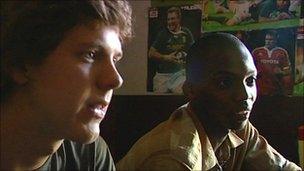Has South Africa's 'racist university' truly changed?
- Published
The University of the Free State now has its first black chancellor
Two years after a video which shocked the world and exposed racial divisions at South Africa's Free State University, the institution is trying to re-invent itself.
One of the most obvious changes is the integration of black and white students into the same residences - a move which was met with great resistance at first.
Junior Mqingwana and Willem Libenberg are room-mates at one of the most conservative universities in South Africa.
Until two years ago, Armentum male hostel was white.

Willem Libenberg (L) and Junior Mqingwana would not have shared in Armentum hostel two years ago
But now students seem to have bought into the idea of racial integration.
"The rugby posters on the wall are mine, not his," smiles Mr Mqingwana, pointing to his white room-mate.
It is a casual comment that would ordinarily be insignificant were it not for the fact that South Africa is still struggling under the burden of racial stereotypes.
Rugby is still largely the preserve of the white population here.
But this pair of law students are a curiosity beyond their sporting preferences.
'White space'
The institution is situated in Bloemfontein - the birthplace of the National Party, which in 1948 became the architect of apartheid.
The city is also where the African National Congress (ANC) was born - the liberation movement that challenged white-minority rule and continues to govern today.
It is therefore not surprising that traditions run deep in this part of the world and the racial harmony that anti-apartheid campaigner and former President Nelson Mandela dreamed of is still an aspiration rather than a daily reality in parts of the Free State.
In 2008, four white students posted a racist video showing a mock initiation ceremony on the internet.
In it five black university workers were made to kneel and forced to eat food which had apparently been urinated on by one of the students
Though it shocked many around the world, many in South Africa were not surprised.
I talked to one student at the time, when halls of residence were segregated along racial lines, who said she had been reprimanded for parking her car in a "white space" while visiting a friend.
To outsiders this might seem bizarre. She was not surprised.
More than a decade after the end of white minority rule, apartheid felt alive and well on campus.
Window dressing?
Now with a court case behind it and the hostel where the guilty students lived closed down, the university's first black Vice Chancellor Professor Jonathan Jansen has made it his mission to smash the racial shackles that tainted the university's reputation.
About 65% of the 30,000 students here are black and most of the 23 halls of residence house students of all races.
It is part of a quota system which has earned Mr Jansen some criticism in the past 18 months.

Alcohol has now been banned on the campus at Bloemfontein
He has also courted controversy with tough new rules banning mainstream political parties and the consumption of alcohol on campus.
But he defends his hard line approach.
"This initiation culture is very strong at this university. We said: 'You won't take your studies seriously if you turn the university into a pub,' and though it is not the kind of language I like to use, we needed to act firmly in the beginning - otherwise we wouldn't have got the kind of leadership and change that we see today," he says.
"Now we can hand it over to student leaders and let them run the place."
His top-down approach alarmed a minority of students.
Tammy Breedt, a student leader from Freedom Front Plus, the party that serves to protect Afrikaner interests which had much influence in student politics until the ban on political parties, says some students moved off campus in protest against the new rules.
"They felt it was window-dressing. You can change the university but you have got to carry the students with it," she says.
Some students, she admits, have not changed their views, perpetuating the prejudices of their parents' generations.
"There's a lot of stereotyping - a lot of baggage we have got to deal with on all sides."
The university made the student leaders responsible for some of the changes, but there are vast cultural differences that need to be overcome and understood.
Locating a new institute for the study of racial reconciliation on site is a small step towards trying to achieve this.
"The difficulty with change is how to give a sense of continuity, especially for the students whose parents studied here," explains Mr Jansen.
Racist jibe
Despite the impressive progress, it will take years to turn this university around - small cultural norms can seem exclusive for some communities and language is still a big cultural barrier.
Lectures are delivered in both English and Afrikaans.
We found students preparing floats for the traditional rag week parade, when brightly decorated vehicles traverse the town raising money for charity.
Most of the students doing the decorating were white.
"Why don't our black students join in?" hisses one woman, who then went on to make a racist jibe that I refuse to repeat.
Next to us a black student was watching the activity from the sidelines.
I asked her whether she enjoys the loud Afrikaans music that blares from the speakers outside. She just smiled.
The university is undergoing an "extreme make-over" and there is clearly much more work to be done.
But the vast majority of students at Kovsies, as the university is affectionately known, are determined the reforms are real not simply cosmetic.